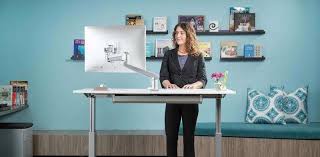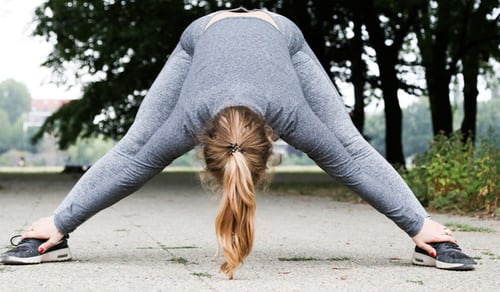I recently splurged and treated myself to a pricey item, one that, supposedly, is going to help improve my health and reduce my risk of heart disease, help me lose weight and drop my cholesterol numbers, AND boost my productivity.
I bought myself a fancy work desk (more like a pretty sizable work counter) that raises and lowers at the tap of a finger. It also has USB cable ports. And it has a black glass surface, so, instead of using post-it notes, I can write notes on it with special wax pencils and then wipe then erase the notes.
Potential dangers of sitting down while working—
According to the insert shipped in the box with the desk, the Journal of Physical Activity and Health found that, on average, people spend 5.8 hours sitting at their desk at work.
I cringed when I read that, since I was putting in longer hours sitting at my desk a little over a year ago. And I paid for it. Am still paying for it, actually, with tighter muscles that scream in protest when I try to re-lengthen them; in stiff knees that are still giving me trouble; and in weight gain I’m still battling to shed.
And I always feel sorry for the receptionists at companies or doctors’ offices who seem to be glued to their chairs, parked before their computers as they check in patients and answer the persistent phone calls.
The insert also sited a Nielsen study that found we spend 58 minutes on a PC or Internet. I don’t know where they got that statistic, but most people I know, who are working, spend a lot more time than that on their computers.
In addition, we spend 1.39 hours on the Internet on our smart phones. And that’s probably spent in the sitting position.
I’ve returned to using my phone way too much for Internet perusing and have laid down some personal rules for myself: I shut down my computer and phone by 7:00 PM (or soon after), and I try to make myself leave the phone alone in the morning, before I’ve spent quality time with the Lord in Bible study, devotion time, and prayer.
Benefits of standing while working—
Productivity:
According to the insert, standing while working can boost your productivity by 46%.
(Daily Science covered the results of a standing-up productivity study published in IIE Transactions on Occupational Ergonomics and Human Factors.)
I’m going to guess that’s one of the reasons it’s true is because most people hunch over their computers, pecking away at their computers with their necks lurching forward and down, their shoulders rounded over, and their eyeballs at the wrong level to really see the screen well. Sitting like that compromises your breathing, tending to make it shallow and unproductive. You don’t get as much oxygen into and through the system, and you tire faster and throw your body alignment out of whack.
Just perching a separate monitor from your laptop on your desk, one that sits up at eye level with you, helps immensely in correcting this.
But standing while working can help circulation. But standing all day to work also comes with vascular risks, so don’t overdo a good thing!
Weight Loss:
Another potential plus is that you can lose weight, up to 20 pounds per year by standing two hours a day, if the insert is correct. The research sited is found on the livestrong.com site.
Improve your cardiovascular system:
Spending less time sitting also helps lower your blood sugar (decrease your risk of acquiring diabetes) and cholesterol (reduce your risk of heart disease). This “fact” was taken from Harvard Health.
I’m already enjoying my desk, and it’s got a great support bar as part of the legs/support system that I can rest my feet on while sitting down, and prop one foot on while standing up. Raising your knees a little higher than your hips also helps circulation while you’re sitting down and working. It certainly makes the sitting position much for comfortable, and I’m less likely to scrunch my legs backward, entwine my feet, and jam my big toes into the ground!
I certainly don’t feel as stiff or pinched up when I rise to take a break, which you should do every forty minutes, at the minimum. Which returns me to the standing up article that says people started feeling physically better after one month of standing up while working. They complained less of physical issues or discomfort.
I’ll keep you posted on the effects. Can’t tell yet if I’m more productive, but I certainly enjoy my time spent at the computer more. And I’m trying to incorporate what I can to improve my health with the goal of making life more enjoyable and being able to perform my work as well as I possibly can.
And the desk looks really sleek in my newly painted study where I work. Now my husband wants one. And I’m considering buying a couple for my sons for Christmas presents.
Standup desk options—
If you can’t buy a fancy desk, consider purchasing a low-cost, hundred-dollar model to set on the dining room table or a card table. The one I got for Christmas a couple of years ago is rated as one of the top stand-up work desks. It’s large enough to spread some papers out on, and it has an easily adjusted height. Having a desk like that gives you the added benefit of changing work scenery, which can also increase productivity.
Do your homework, though. Mobile desks can get REALLY pricey; and some users complain that the electronics on them fizzles out pretty quickly.
But Buyer Beware!
Take note that there is no specific, science-backed research data on how long you should spend sitting versus how long you should spend standing while working. And don’t convince yourself that your standing at work replaces outdoor activity—like walking—or general exercise to raise your heart rate. It’s just one more piece of the health puzzle to consider.
Until next week, sit down less, stand up and move around more, and work healthy! To feel better physically.
Blessings,
Andrea
Andrea Arthur Owan is an award-winning inspirational writer, fitness pro and chaplain. She writes and works to help people live their best lives—physically, emotionally, and spiritually.




